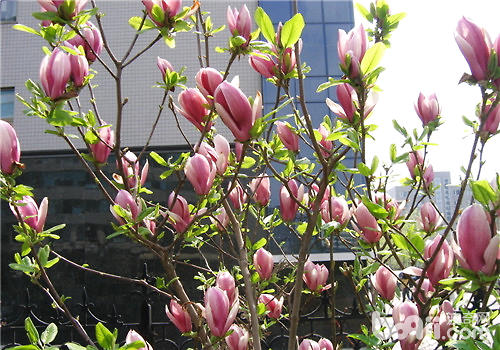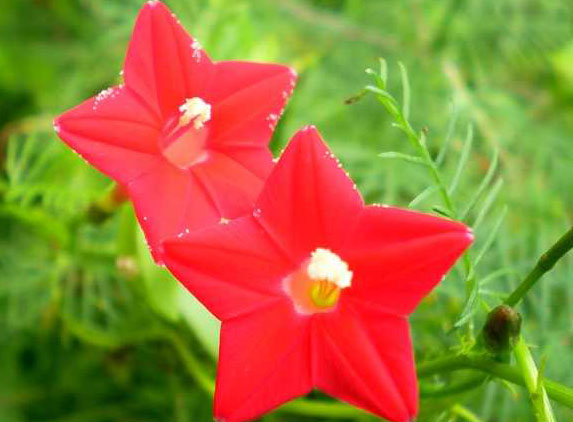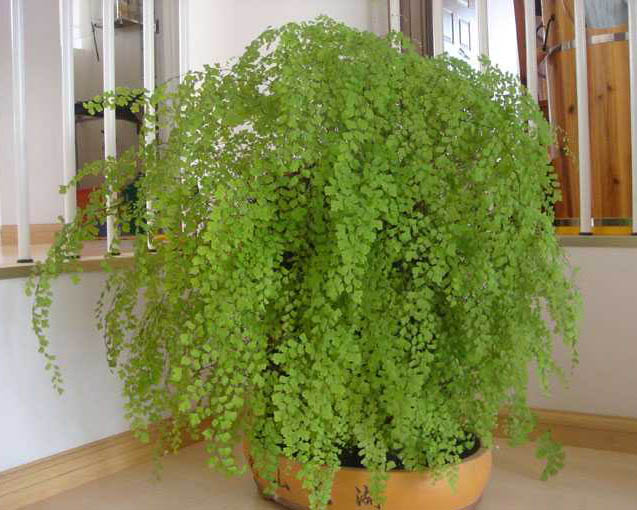What are the key points of cultivation and management of Magnolia?
Magnolia is known as Magnolia. For deciduous leaves. Flowers large, pure white, with fragrance, calyx and petals indistinguishable, a total of 9, the first leaves open. Common cultivated flowers of the same genus are purple magnolia, cinnabar magnolia, night incense magnolia, magnolia, and so on.
The planting site of ① Magnolia should be sheltered from the wind and sunny, with high and dry terrain, good drainage, deep and loose and fertile soil. It is suitable for transplanting when the leaves are just unfolded after the flowers fade in spring. Take the clot with you when transplanting, and cut the leaves properly to reduce water evaporation. When cutting leaves, we should pay attention to keep the petiole to protect axillary buds. Before planting, apply enough mature organic fertilizer at the bottom of the pit, and pour water after planting.
During the growth of ②, liquid fertilizer was applied twice as appropriate. After planting, Magnolia magnolia has a strong fragrance when it is applied with one-time quick-acting liquid fertilizer before and after flowering. After entering, ditch and apply fertilizer again to promote the formation of flower buds at the end of summer, which is beneficial to blossom in the following spring.
There are not many branches of ③ Magnolia, and the healing ability of injured □ is poor, so it can not be pruned, but the withered branches, disease and insect branches and branches that disturb the tree shape should be cut off when the leaf buds begin to spread after flower fade. If there is no seed left after the flower fade, the ear of the pod should be cut off so as not to consume nutrients and affect the flowering of the following year.
In the early stage of ④ planting in the north, it is necessary to cover with soil or leather to protect against cold in winter. The key points of management of Magnolia in open field cultivation in north China are drought prevention in spring, waterlogging prevention in summer, dampness prevention in autumn and cold prevention in winter.

Purple magnolia
Water and fertilizer: purple magnolia likes to be moist and afraid of waterlogging, so timely and appropriate watering is very important. When the Beginning of Spring blossoms, the potted soil remains moist but not wet; after flowering, the potted soil remains moist but not waterlogged; after defoliation, the potted soil remains moist but not dry. Do not be dry or waterlogging at any time, especially in the rainy season.
Magnolia likes fertilizer. Fertilization should seize the two key opportunities of 2 months before flowering and 5 months after flowering. Nitrogen, phosphorus and potassium compound fertilizer should be applied once every ten days. The former makes buds expand and flowers bloom, while the latter promotes more pregnant buds and more flowers in the next spring. When the leaves fall in winter, the fertilizer mainly composed of phosphorus and potassium is applied once to enhance its ability of resisting cold and overwintering, with little or no application in the rest of the time. Avoid applying nitrogen fertilizer alone.
Light and temperature: purple magnolia like light, placed in the sunny courtyard, roof garden, the sun grows strong and luxuriant, although it can grow under semi-shady conditions, but it is thin and has few flowers, and if it is too overcast, there are no flowers. It is hardy and can survive the winter outdoors in Beijing and its southern areas.
Pruning: the root of Magnolia mandshurica has strong sprouting and tillering ability. if there is no need for reproduction, cut along with the growth and keep 3 trunk in each pot. For branches that are too tall and too long, they can be cut short just after flowering. Because of their poor healing ability, they should be coated with sulfur powder for anticorrosion after cutting, and do not prune if it is not necessary. If there is no need to leave seeds for reproduction after flowering, the residual flowers should be cut off with pedicels.
Propagation methods and key points of cultivation and Management of Magnolia Magnolia
How to cultivate Magnolia Magnolia? What is the difference between red magnolia and red magnolia? The main difference is that Magnolia blossoms three times a year in spring, summer and autumn in the south, with red petals outside and white inside. Let's learn about the variety characteristics and breeding methods of Magnolia.
1. Morphological characteristics
Magnolia is a deciduous shrub with fragrant petals from purplish red to light red to white. Petal-shaped, elliptic-Obovate. Aggregate fruit dark purple-brown, brown, cylindrical. Mature oysters subglobose, with a short beak at the tip.
two。 Growth habit
Like sunshine, suitable for growth in a warm and humid environment, slightly resistant to semi-shade and cold. It is possible to spend the winter in open fields in most parts of our country. It is suitable to grow in acid sandy soil with fertile moisture and good drainage, and it can also grow in weakly alkaline soil. Because it is fleshy root, it is neither resistant to drought nor stagnant water. Should be planted in shelter, sunny, no stagnant water areas.
3. Reproduction
3.1 Cuttage and striping propagation
In cutting propagation, the cutting time has a great influence on the survival rate, which is generally carried out from May to June, and the survival rate of young trees is the highest in the same year. Soaking the base with 50ppm naphthylacetic acid for 6 hours could increase the rooting rate. When striping propagation, the plants with good growth were selected, and the 1-2-year-old branches of thick 0.5cm were used as strips. If there are branches, they can be pressed on the branches. The time of striping is 2 ~ 3 months. The longer the connection time between the rooting and the mother plant is, the more developed the root system is and the higher the survival rate is. It can blossom 2-3 years after planting.
3.2 grafting propagation
From December of the previous year to January of the following year, the annual branches of 'Hongyun' Magnolia were selected as scions with strong growth, no diseases and insect pests, full axillary buds and dormant period, and the leaves were cut off and some petioles were reserved. The length of petiole is as long or short as axillary bud. The 2 ~ 3-year-old yellow orchid with strong growth, developed root system and no diseases and insect pests was selected as the rootstock.
Adopt the splicing method:
(1) scion cutting. The grafting knife is used to cut the plane of about 2 ~ 3cm on one side of the long axillary bud of the scion, the best depth is to cut off the phloem and expose the xylem, and then cut a short section of 45 °on the corresponding side to ensure that the lower end is thin.
(2) cutting rootstock. According to the size of the scion, the skin of the rootstock is thick, smooth, smooth, without scar or pest-free, the depth is not harmful to the xylem of the rootstock, and the length is the cutting length of the long side of the scion.
(3) joining. Pick up the bark of the rootstock with the tip of the grafting knife, and insert the long side of the scion toward the xylem of the rootstock and insert it into the incision of the rootstock, so that the scion is close to the xylem of the rootstock.
(4) bandaging. The rootstock and scion were tightly wrapped with grafting film to prevent Rain Water and germs from invading and to maintain humidity. Among them, the axillary buds were coated with only one layer of grafting film to prevent the axillary buds from growing and dying because of too many coating layers and the axillary buds could not break through the grafting film.
(5) Management after grafting. The amount of water was determined by observing the condition of water fog in the grafting film. The fine and uniform water droplets on the grafting film indicate that the water content of the rootstock is suitable. The overflowing water on the rootstock in the grafting film indicates that there is too much water, which should be controlled. If there is little water fog in the grafting film, it means that there is a lack of water and should be watered immediately. As the scion sprouted and grew, the water demand gradually increased. Remove the film on the interface when the scion reaches 30~40cm, and then manage it according to the normal seedling water demand, that is, watering once every 2-3 days. For the scion that grows too high and too strong, set up a stick next to the rootstock and gently tie the scion to the stick with a rope to prevent the scion from breaking at the interface between the scion and the rootstock caused by excessive wind. The survival rate of grafted seedlings propagated by this method is generally about 80%.
'Hongyun Magnolia 1.5cm, as high as 1.5m above. Cut the trunk at 0.8 ~ 1.0 m above the ground in the winter of the following year, leave a thick and strong branch as the trunk in the winter of the third year, trim the side branches properly, and trim the crown into an egg shape year by year, so that the seedlings can be planted in the nursery.
In tissue culture, the shoots of 'Hongyun' Magnolia were selected in January and cut into about 2~3cm. The long silk hairs on the buds were gently scraped with a blade in running water, washed for 30 minutes, sterilized by 70% alcohol and sterilized by 30s+0.1%HgCl2 for 14 minutes, then washed with sterile water for 5 times. The explants were cut short and inoculated in MS basic medium for 16 hours a day, light intensity 2000lx, temperature 25 ℃ ±1 ℃. Tissue culture room for 4 ~ 5 weeks. Then the adventitious buds could be differentiated by inoculating them in the good medium for bud proliferation (MS+BA0.5mg L+NAA0.5mg/L+KT1mg/L).
4. Cultivation and management
4.1 Transplant
Planting should not be too early or too late, and it is most suitable to plant 10 days before sprouting in early spring or before spreading leaves after flower fade. Sowing seedlings should be properly shaded in summer for 1 ~ 2 years after they are unearthed, and should be protected against cold after winter in the north. It is better to transplant before sprouting, or before flowers are just shedding, or before spreading leaves. When transplanting, regardless of the size of the seedlings, the roots should carry mud clumps, and be careful not to damage the roots as far as possible to ensure survival. At the same time, try to avoid planting in low-lying areas where water is easy to accumulate.
4.2 temperature
'Hongyun 'Magnolia is not very strict about temperature. However, moderate shading or cooling is needed when it is hot and high temperature, 12 ∶ 00 ~ 16 ∶ 00:00 every day to avoid scorching sun exposure, but also to avoid high temperature radiation of brick walls or cement floor. At this time, it is not only necessary to spray water to the plant to cool down, but also to water or spray water to the ground to cool and dissipate heat, so as to increase air humidity. Overwintering in the north needs to wrap the trunk with grass rope or linen cloth, and the roots are watered thoroughly before winter.
4.3 Lighting
'Hongyun 'Magnolia needs plenty of sunlight and should be maintained on sunny land with long sunshine and strong light during its growth. The light should not be less than 6 hours a day. If planted in a shady place, there will be only long leaves without flowering, or very few flowers, slender branches, light leaves, thin leaves, no luster, which is disadvantageous to growth.
4.4 moisture
'Hongyun 'Magnolia not only needs water but is afraid of stagnant water. In the seedling stage, water should be watered once a day from summer to early autumn to keep the soil moist, but in the hot summer morning and evening, water should be irrigated and sprayed on the leaves to increase air humidity. Irrigation with tap water needs to prevent soil Alkalization. If it is found that leaf yellowing should be treated with ferrous sulfate or 0.7% ~ 0.8% acid vinegar water to water the root, or 0.3% ~ 0.4% acid vinegar solution can be used to spray leaves, the effect is very good. Don't accumulate water in the rainy season, or the roots will rot.
4.5 Fertilizer
Because 'Hongyun' Magnolia has a long flowering period and many flowering times, it is necessary to replenish nutrients regularly. In addition to applying sufficient base fertilizer at the time of planting, organic liquid fertilizer dominated by phosphorus and potassium (such as rotten cake fertilizer and water) can also be applied every 10 days from March to October of flowering. The principle of fertilization is to apply thin fertilizer frequently, and you can also take the method of first light and then thick. you can't apply raw fertilizer, otherwise it will burn roots. At the same time, extra-root fertilization was carried out every half a month, and leaves were sprayed with 0.5% plant oxytocin and 0.3% potassium dihydrogen phosphate.
5. Pest control
Underground pests such as blight, root rot and grubs should be prevented at seedling stage. Longicorn beetles are harmful to stems, and red spiders should be prevented in midsummer. In the process of management, attention should be paid not only to the prevention and control of chlorosis and root rot, but also to anthrax. If the disease is found, the diseased leaves of diseased plants should be removed in time, and 50% carbendazim 500-1000-fold aqueous solution should be sprayed to the leaves, or 70% methyl topiramate 800-1000-fold solution should be used for control. It is found that aphids or shell insects harm buds and buds, which can be controlled by 1000 times of imidacloprid or 750 ~ 1000 times of thiazine.
The above is the whole content of breeding and pest control cultivation techniques of Magnolia magnolia. Interested florist friends are welcome to come to Huinong Network to learn a lot!
- Prev

How to propagate and cultivate Prunus mandshurica
Feather leaf pineapple, famous pineapple, dragon grass and so on. The leaves are green and slender, the stems are twisted and coiled, and the potted plants can be built into frames of various shapes to make the stems and leaves grow on them. Like warmth and sunshine, not cold-resistant, self-sowing, regardless of soil. Commonly used sowing and propagation, suitable for spring direct seeding, not resistant to transplanting
- Next

How does Dryopteris reproduce
Dryopteris can be propagated by ramets and spores. Ramet should be carried out when changing pots in spring. When ramet, take the mother plant out of the basin, pick open the rhizome by hand, and divide it into 3-4 clumps, which can be planted separately. Be careful not to damage the root system during operation in order to survive. After the spores of the leaf margin mature in a warm, shady and humid environment.
Related
- Fuxing push coffee new agricultural production and marketing class: lack of small-scale processing plants
- Jujube rice field leisure farm deep ploughing Yilan for five years to create a space for organic food and play
- Nongyu Farm-A trial of organic papaya for brave women with advanced technology
- Four points for attention in the prevention and control of diseases and insect pests of edible fungi
- How to add nutrient solution to Edible Fungi
- Is there any good way to control edible fungus mites?
- Open Inoculation Technology of Edible Fungi
- Is there any clever way to use fertilizer for edible fungus in winter?
- What agents are used to kill the pathogens of edible fungi in the mushroom shed?
- Rapid drying of Edible Fungi

